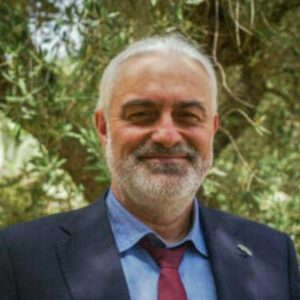Research Director at the Hellenic Centre for Marine Research, Institute of Marine Biology, Biotechnology and Aquaculture, former Head of the Biodiversity Laboratory and former Coordinator of the LifeWatchGreece Research Infrastructure and National Delegate to LifeWatch ERIC General Assembly.
His scientific focus is on marine biodiversity, biodiversity informatics, functional diversity, and coastal ecosystems. He works on the comparison of marine biodiversity information patterns derived from different levels of biological organisation and scales of observation, and develops new approaches to explore their interrelationships.
Involved in more than 100 research and education projects, coordinated 15. Research funding ID: more than 70 M€. More than 100 peer-reviewed scientific papers, including 3 monographs. Associate editor in the journals: Diversity, Frontiers in Marine Science, Biodiversity Data Journal; Handling Editor in Mediterranean Marine Science; Guest Editor in Marine Ecology Progress Series and Journal of Sea Research;
As CEO of LifeWatch ERIC, Dr. Arvanitidis’ current focus is on promoting open science in biodiversity and ecosystem research through technological innovation and developing collaborative interfaces between Research Infrastructures for the creation of new knowledge and innovation.
Main publications:
1. Arvanitidis C, Somerfield PJ, Chatzigeorgiou G, Reizopoulou S, Kevrekidis T, Eleftheriou A (2009) Do multivariate analyses incorporating changes in pattern across taxonomic levels
reveal anthropogenic stress in Mediterranean lagoons? Journal of Experimental Marine Biology and Ecology 369: 100–109; DOI: 10.1016/j.jembe.2008.10.032
2. Kissling DW, Ahumada JA, Bowser A, Fernandez M, Fernández N, Alonso García E, Guralnick RP, Isaac NJB, Kelling S, Los W, McRae L, Mihoub J-B, Obst M, Santamaria M, Skidmore AK, Williams KJ, Agosti D, Amariles D, Arvanitidis C, Bastin L, De Leo F, Egloff W, Elith J, Hobern D, Martin D, Pereira HM, Pesole G, Peterseil J, Saarenmaa H, Schigel D, Schmeller DS, Segata N, Turak E, Uhlir PF, Wee B, Hardisty A (2019) Biological Reviews 93: 600–625; DOI: 0.1111/brv.12359
3. Karagiannidis E, Papazoglou AS, Sofidis G, Chatzinikolaou E, Keklikoglou K, Panteris E, Kartas A, Stalikas N, Zegkos T, Girtovitis F, Moysidis DV, Stefanopoulos L, Koupidis K, Hadjimiltiades S, Giannakoulas G, Arvanitidis C, Michaelson JS, Karvounis H. Sianos G (2021) Micro-CT-Based Quantification of Extracted Thrombus Burden Characteristics and Association With Angiographic Outcomes in Patients With ST-Elevation Myocardial Infarction: The QUEST-STEMI Study. Frontiers in Cardiovascular Medicine Volume 8: 646064; DOI: 10.3389/fcvm.2021.646064
